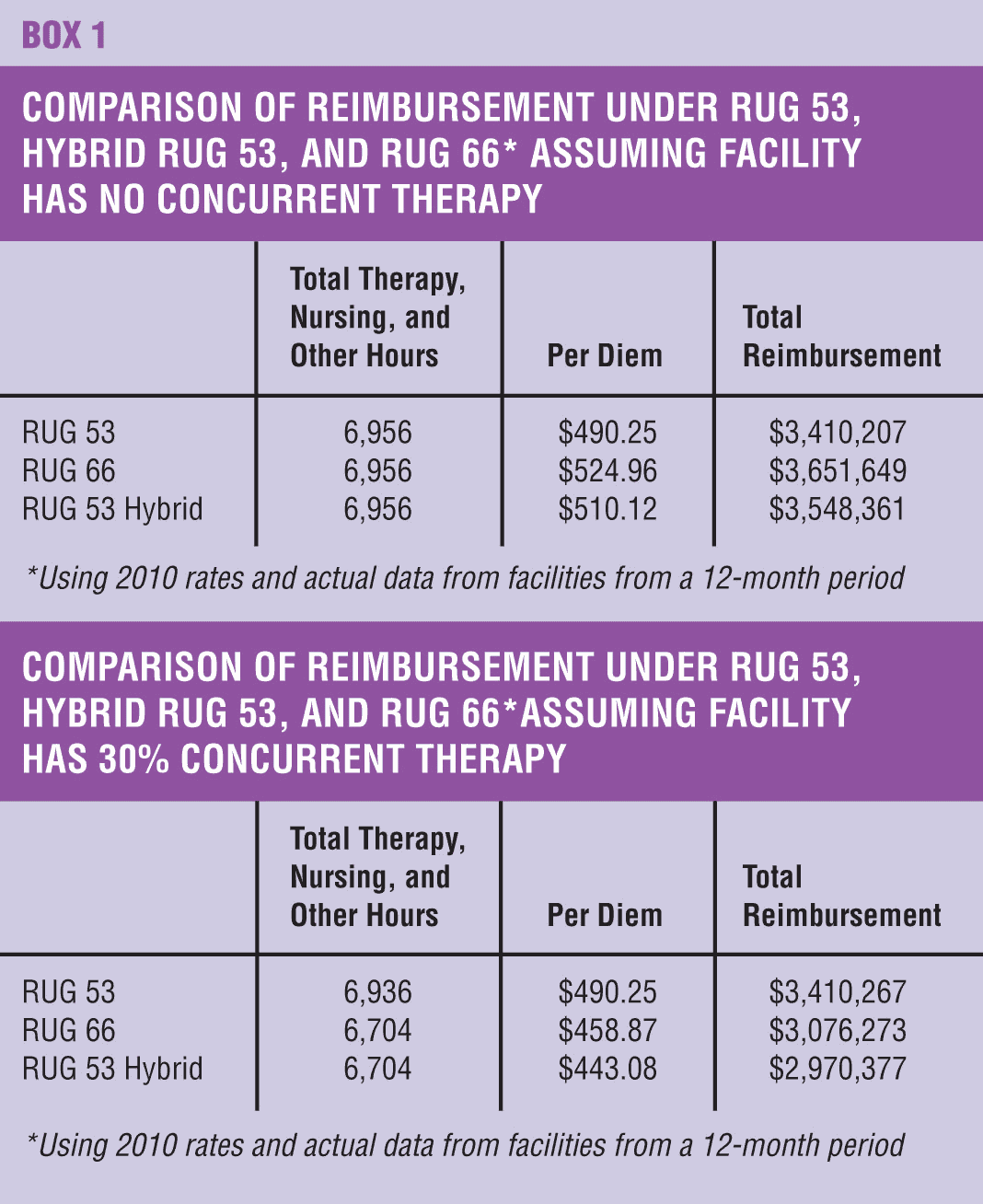The implementation date for the new minimum data set (MDS) 3.0 has come and gone, but the confusion surrounding how it will impact reimbursement under the new Resource Utilization Group (RUG) IV levels remains. Providers that wish to avoid drastic reimbursement cuts and realize potential revenue gains under the new therapy rules should review the comparisons presented in this article and conduct a thorough review of individual, group, and concurrent therapy provided in their facilities.
Extensive Changes
Why is this so important? Under RUG-IV, concurrent therapy minutes will be allocated among the patients instead of being counted as one-on-one therapy minutes. Concurrent therapy is defined as treating no more than two patients in differing therapies regardless of payer source, both of whom must be in the line of sight of the treating therapist.
Group therapy, which is unchanged in RUG-IV, consists of two to four patients who are performing the same or similar activities and are supervised by a therapist who is not supervising other individuals. Group therapy is capped at 25 percent of total therapy hours.
The Centers for Medicare & Medicaid Services (CMS) redesigned the MDS so that it collects and reports individual therapy minutes separately from concurrent therapy and group minutes.
Along with the newly designed MDS, new RUG categories were created to coincide with the release of the MDS 3.0. According to the CMS final rule on the topic, overall payments under RUG-IV will be at the same level as they would be under RUG-III.
The difference with RUG-IV is that the distribution of payments will change, meaning that the payment rates for the complex groupsextensive care, special care, and clinically complex carewill increase significantly.
The new RUG-IV categories are: Rehab Plus Extensive Services, split into Ultra High, Very High, High, Medium, and Low; Rehab, split into Ultra High, Very High, High, Medium, and Low; Extensive Services; Special Care High; Special Care Low; Clinically Complex; Behavioral Symptoms and Cognitive Performance; and Reduced Physical Function.
Impact On Reimbursement
To illustrate how the changes in concurrent therapy will impact reimbursement under RUG-IV, this article presents a simulation (see Box 1, below) of therapy and payment scenarios under the new RUG 66 grouper, with varying levels of concurrent therapy, the current RUG 53 levels, and also under the hybrid 53 levels, expected to be ready in the next several months. (CMS is currently paying on the RUG-IV system, which is not scheduled for implementation until Oct. 1, 2011, and then recalculating the rate in February 2011 or thereabouts under the hybrid 53 grouper.)

The simulation applies 2009/2010 year-to-date Medicare Part A data from multiple skilled nursing
facilities.
This comparison assumes that CMS will estimate its hybrid grouper 53 by using the RUG 66 therapy rules and RUG 53 nursing services rules. For the RUG-IV side of the comparison, therapy minutes for concurrent therapy were reduced across all RUG levels.
It is notable that the RUG 66 source code provided by CMS and used to create the RUG-IV was used to generate the RUG 66 model. This source code is available to any and all who ask for it. Here, the RUG 66 code is applied to calculate the hybrid RUG 53 therapy days and the RUG 53 current code to generate the nursing levels and days that may fall below skilled levels of care as defined by Medicare policy.
Decision Time
These scenarios place long term and post-acute care executives in a challenging decision mode.
The options are to ignore the forecast and pray for luck or to evaluate the forecast, learn from the model, and evaluate how to act today to improve the future.
Based on this simulation, providers that do not lower the application of concurrent therapy in the model will see a significant reduction in Medicare payment for services.
Illustrating how therapy levels will change under RUG-IV is another table (Box 2, below) that takes therapy minutes as they were under RUG-III and MDS 2.0 and allocates them under RUG-IV with a 30 percent concurrent therapy utilization to show how levels will likely shift to lower payment categories.
Prepare For CMS Recoupment
Providers should use the lesson of these tables to establish a reserve for potential CMS payment recoup for services as the agency begins to apply the hybrid 53 grouper to the payments made under RUG-IV.
The potential recoupment under RUG-IV can be determined by the difference between the RUG-IV and hybrid 53 reimbursements. Hence, it is important to evaluate and manage resources for the best implementation of care for Medicare beneficiaries.
Under the hybrid 53 grouper, CMS will pay according to the RUG-IV, re-evaluate that payment, and then adjust facility payments.
The requirement imposed by the Patient Protection and Affordable Care Act to delay the RUG-IV implementation until Oct. 1, 2011, imposed on CMS is daunting.
CMS must eliminate the RUG 53 hospital look-back service capture, eliminate estimated therapy, and discount payment for concurrent therapy, all items captured in the MDS 3.0, but with an MDS 2.0 payment structure.
As a result, providers must reserve funds for the possibility that some will need to be paid back to CMS.
For FY 2011, providers will need to improve their utilization of therapy resources to increase group therapy and one-on-one therapy and reduce the use of concurrent therapy. Even a 1 percent concurrent therapy level will reduce Medicare payment. However, it is unrealistic to eliminate concurrent therapy altogether.
The big challenge for leadership will be to manage a balance and, by managing a balance, achieve budget neutrality.
Next month, Provider will examine how RUG-IV and MDS 3.0 will impact staffing needs for rehabilitation therapy.
John Sheridan, president of eHealth Data Solutions, a health care information company based in Cleveland, Ohio, has more than 30 years of experience in the health care industry as a strategic advisor, analyst, and entrepreneur serving the pharmaceutical, hospital, physician, and long term care professions. He can be reached at (937) 767-1885.